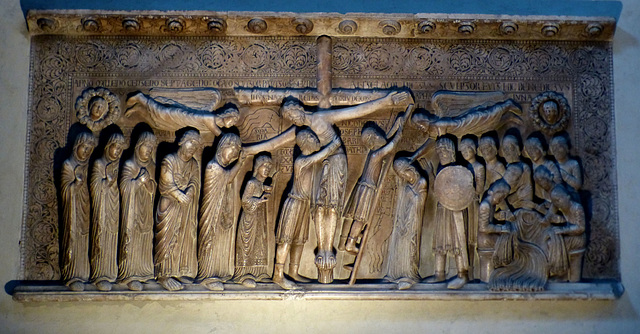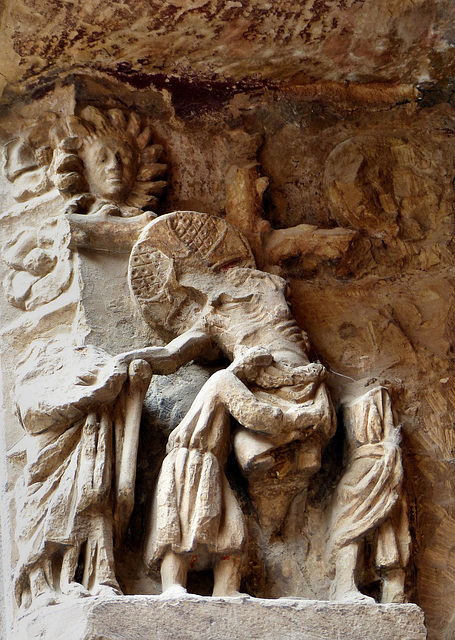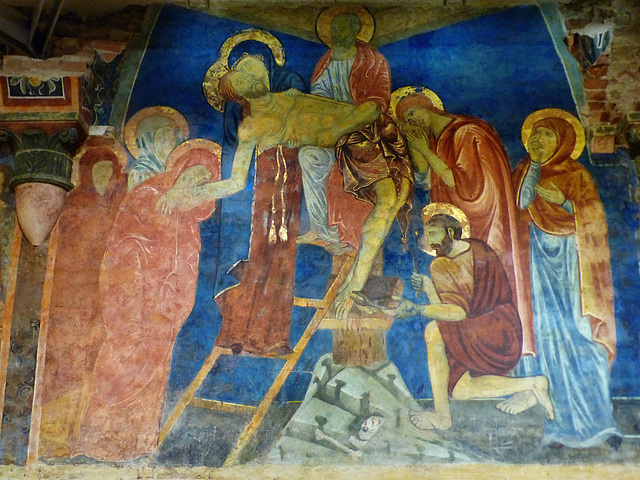
Descent from the Cross / Joseph of Arimathea
Verona - Basilica di San Zeno
Already Theodoric the Great, King of the Ostrogoths, may have funded a church, erected over the tomb of Saint Zeno, who, following the legends, was born in Mauretania and died around 380 in Verona.
The erection of the present church began in the 9th century. Soon after San Zeno´s relics were translated into the new church. At that time Charlemagne´s son Pepin (aka "Pepin of Italy") resided in Verona and a large Benedictine monastery grew all around the church.
When the Magyars invaded Italy in the early 10th century, the church got severely damaged, but the relics were not harmed, as they had been taken out and were hidden. In 967, a new church was built with the patronage of Otto I.
On January 3, 1117, the church was damaged by an earthquake, that ruined so many buildings in Northern Italy. The church was restored and got enlarged in 1138.
It may well be, that soon after panels of a bronze door from another (destroyed?, damaged?) church were transferred to San Zeno - and so got reused here. Today the famous bronze door consists out of two panels on which the plates are fixed. The older ones (~ 1100) are often compared with the bronze works in Hildesheim, and Saxon Masters may have worked here. The younger ones (1200) are "smoother" and some scholars connect them to Benedetto Antelami, who worked in Parma 1178 ("Deposition").
Unfortunately the room is so small, that I was unable to take an "overview", so I could only take photos of panels and details.
The "Descent from the Cross"
Joseph of Arimathea and Nicodemus taking Christ down from the cross.
Parma - Duomo di Parma
Parma, part of the Holy Roman Empire since Charlemagne´s times, was locally ruled by its bishops. During the long Investiture Controversy, Parma was (mostly) member of the Imperial party ("Ghibellini"). Two of Parma´s bishops even became antipopes: Càdalo as Honorius II and Guibert as Clement III.
A paleochristian basilica had existed here in the 6th century. This church burnt down and got replaced in the 9th century by Bishop Wibod. This cathedral was destroyed by fire in 1055.
Bishop Càdalo (= antipope Honorius II) begun the construction of the Duomo di Parma in 1059. The Cattedrale di Santa Maria Assunta got consecrated in 1106, but the new church was heavily damaged by the earthquake in 1117 and had to be restored.
Originally the Duomo was erected on a Latin cross plan, with a nave and two transept arms. Later chapels and structures were added, so by now, the plan is pretty complex.
It is actually not allowed, to take photos inside the Duomo di Parma, but nevertheless I took a few. Very few.
The "Descent from the Cross", created and signed in 1178 by Benedetto Antelami, is (for me) the most fantastic work in the Duomo. It is believed that Benedetto Antelami has served as apprentice at Saint-Trophime d'Arles in his early years. So there are parallels to the "style provençal".
Antelami´s signature is above the right cross-beam.
Externsteine
Showing the upper part of the relief of the Descent from the Cross. On the left is the opening to a little cave, used as a hermitage, dated by some historians as early as 9th century. The carving itself was done probably within the 12th century.
Logroño - San Bartolomé
San Bartolomé is the oldest church of Logroño. The construction dates back to the 12th century. Though it got altered largely in the 16th century, the Romanesque structure is still visible.
During the time of "La Desamortización", when mid 19th century many monastic properties got sold, the church was used as a warehouse and workshop. It was even discussed to demolish the building.
The porch was created in the 13th century.
Below the large vignettes themed about Saint Bartholomew's life and death are small, very nice scenes. Here is a "Descent from the Cross".
Joseph of Arimathea takes the body of Jesus down from the cross. A 13th century legend tells, that Joseph in his old age travelled to England and buried the Holy Grail in Glastonbury.
Le Douhet - Saint-Martial
In the center of Le Douhet, a village just 12 kms north east of Saintes, is Saint Martial, a 12th century structure, that had to be stabilized by buttresses within the 15th century, when a steeple was built.
The western facade is richly decorated with friezes and archivolts over the portal and the flanking blind arches. There are as well some remarkable corbels. Some of them are weathered, like this "Descent from the Cross". Joseph of Arimathea takes the body of Jesus down from the cross. A 13th century legend tells, that Joseph in his old age travelled to Glastonbury, where he buried the Holy Grail.
Ruffec - Eglise de Prieure
Whatever is left from the priory Saint-Alpinien, dependent from the Abbey of Saint Martial in Limoges, that existed in Ruffec in the 12th century, is privat property today. The large church of the priory got heavily damaged and the only carving, that I found on the facade is this weathered "Descent from the Cross".
Romeno - Santi Bartolomeo e Tommaso
Romeno is a small village in the Val di Non. The small church, outside the village, is surrounded by orchards. It may date back to the 8th century, though it was mentioned first time in 1187. Soon after the interior walls of Santi Bartolomeo e Tommaso were adorned with murals.
Some of the frescoes (dated to 1210) still exist.
The Descent from the Cross.
The person to the left could be Mary Magdalene, Joseph of Arimathea (or Nicodemus) holds the body (near the chest), followed by John the Apostle and Mary.
Matthew 27:57-58
"As evening approached, there came a rich man from Arimathea, named Joseph, who had himself become a disciple of Jesus. Going to Pilate, he asked for Jesus’ body, and Pilate ordered that it be given to him."
John 19:38-39
"Later, Joseph of Arimathea asked Pilate for the body of Jesus. Now Joseph was a disciple of Jesus, but secretly because he feared the Jewish leaders. With Pilate’s permission, he came and took the body away. He was accompanied by Nicodemus, the man who earlier had visited Jesus at night.."
Le Douhet - Saint-Martial
San Martial, parish church of Le Douhet is a 12th century structure, that had to be stabilized by buttresses within the 15th century, when a steeple was built and the building got unbalanced and unstable.
The portal, erected in the typical Saintonge-style, is richly decorated. Here is a corbel, depicting the "Descent from the Cross".
John 19:38
"After these things Joseph of Arimathea, who was a disciple of Jesus, but secretly for fear of the Jews, asked Pilate that he might take away the body of Jesus, and Pilate gave him permission. So he came and took away his body."
The stones, used in medieval times all over the Saintonge, were very soft and so ideal for complex carvings. Unfortunately they weathered over the centuries.
Siena - Duomo di Siena
A cathedral and a bishop's palace existed here already within the 9th century. The construction of the cathedral of today started in 1196, about 150 years later, the church may have been completed, but a massive addition of the cathedral was planned in 1339.
It would have more than doubled the size of the structure by means of an entirely new nave and two aisles ranged perpendicular to the existing nave. The planned cathedral would have been larger than (old) Saint Peter in Rome, it was never completed.
The construction was halted by the Black Death in 1348. Then errors in the static of the building got evident.
A kind of under-church, that was underneath the choir of the cathedral had to be filled up, to give stability... and got completely forgotten.
In 1999 this crypt was found and got excavated over the next years. There are some phantastic frescoes from around 1280. As they had been in the dark for centuries, the colours are surprisingly - clear.
Here the "Descent from the Cross".
Jump to top
RSS feed- Latest items - Subscribe to the latest items added to this album
- ipernity © 2007-2025
- Help & Contact
|
Club news
|
About ipernity
|
History |
ipernity Club & Prices |
Guide of good conduct
Donate | Group guidelines | Privacy policy | Terms of use | Statutes | In memoria -
Facebook
Twitter










